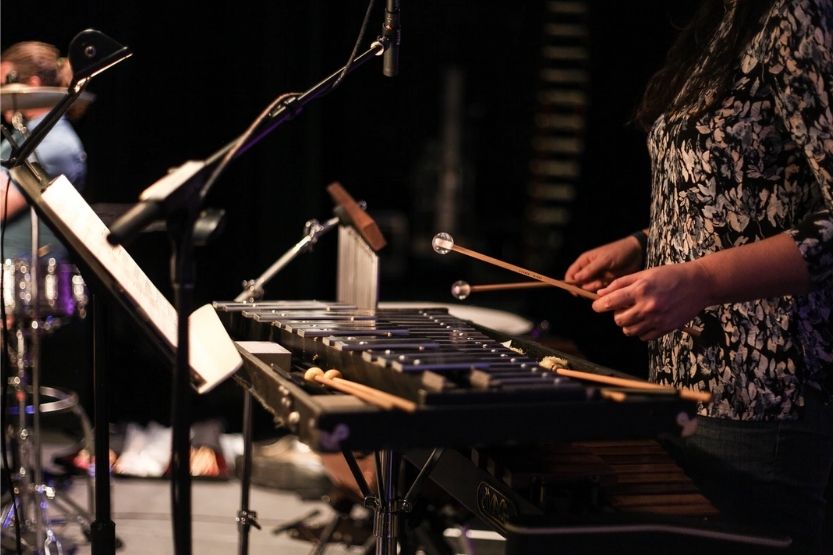At first glance, the glockenspiel and xylophone look very similar to each other. Both are percussion instruments, and to produce sounds, and you have to hit them with a mallet. Glockenspiel vs. xylophone – what’s the difference?
The main difference between the glockenspiel and xylophone is the material for their bars (keys). The bars of the glockenspiel are made of steel, while the xylophone bars are made of wood. These bars produce musical notes or sounds when hit with a mallet.
The names of these two instruments precisely reveal their differences. ‘Glocken’ in the word glockenspiel means bells (made of metal) in Germany. ‘Xylos’ in the word xylophone is a Greek word that means wood.
Read on to learn more about the difference between the xylophone vs. glockenspiel, including their origins.
Also, we hope you find the links here useful. We may get a commission if you purchase something through a link on this page, so thank you!
Glockenspiel Vs Xylophone

The glockenspiel and the xylophone are both musical instruments that belong to the percussion family. A player produces the sound from these instruments by hitting their bars (keys) with a mallet.
Just looking at their appearances, you would think that a glockenspiel is the same as a xylophone. However, when you take a closer look at these two percussion instruments, you will notice one of their big differences. The glockenspiel bars have metal or steel, while the xylophone bars have wood.
In fact, their names accurately reveal what they really are. Glockenspiel contains the German word ‘glocken.’ Meaning, bells typically made of metal. Meanwhile, the word xylophone contains the word ‘Xylo.’ This is a Greek word that refers to wood.
Other than this basic difference, there are other differences between these two musical instruments. Most of the content of this article will dwell on these xylophones vs. glockenspiel differences.
What Is a Glockenspiel?
Click here to see this Eastar Professional 32 Note Glockenspiel on Amazon.
The glockenspiel is a percussion instrument that has tuned bars or keys. The keys of glockenspiel are arranged like the keys of a piano. This arrangement is also similar to a xylophone.
Small mallets or hammers strike the bars of the glockenspiel to produce musical notes. It is partly because it has a frame similar to a lyre’s shape, an antiquated stringed instrument. This instrument originated in Germany, where Christian churches have bells in their steeples.
In the 17th century, players used steel bars instead of bells. Later on, the makers integrated steel bars into the glockenspiel. That is where it got its name. Glocken is a German word that means bells. The complete term ‘glockenspiel’ is transliterated as ‘bells play.’ As time went on, the metal bars were eventually replaced by metal plates or metal tubes.
Different Names of Glockenspiel
The glockenspiel can have different names. In France, it is a carillon, while in Germany, a carillon is similar to a glockenspiel. The Italian word Campanelli is also used to refer to glockenspiels in music stores.
This instrument consists of 2 1/2 octaves of metal plates or steel bars. It produces higher frequencies that typically range from G5 to C8. The whole instrument sits horizontally with its steel bars arranged like a piano keyboard.
Its black keys are also above the white keys. The case of the instrument serves as its resonator. It doesn’t need an amplifier to be able to hear the sounds it produces. In music sheets, players usually write the notes on this instrument two octaves lower than actual.
How Do You Play Glockenspiel?
To produce bright sounds or notes, the player hits the plates with hard mallets. For soft sounds, the player uses a soft rubber mallet. And a player plays the smaller version of the glockenspiel vertically. This is the instrument that you see played in marching bands.
Interesting Facts About the Glockenspiel
The word glockenspiel is from the German words ‘glocken’ and ‘spiel.’ Glocken means ‘bells’ and spiel means ‘set.’ Players used these two words because it has a frame similar to a lyre, a stringed instrument that was invented and played in ancient times.
Originally, the glockenspiel is a set of bells that are graduated in pitches. Later on, they replaced the bells with a set of tuned bars made of steel. Players of these instruments strike the steel plates with mallets made of wood, ebonite, and sometimes with hammers made of metal.
Learning how to play the glockenspiel will be easy for those who already know how to play the piano. They can easily familiarize themselves with the tones the glockenspiel produces. The only difference is that instead of hitting the keys with their fingers, they use a mallet to hit the keys the same way a drummer uses a drumstick to hit a snare drum.
Click here to see this Professional Red Wooden Soprano Glockenspiel on Amazon.
What Is a Xylophone?
Click here to see this RAONZENA Professional Xylophone on Amazon.
A xylophone is a percussion instrument composed of a series of wooden bars. These bars have graduated lengths that produce the musical scale. To produce the notes, the player hits the bars with two small hammers made of wood.
The term xylophone is taken from the Greek word ‘Xylo,’ meaning wood, and ‘phone’ meaning sound. Transliterated, it means wooden sound.
Where Did the Xylophone Come From?
Some say this instrument originated in Africa, while others say that it came from Southeast Asia. Those in favor of Africa claim that this instrument’s earliest written account was in the 14th century, particularly in Mali, Africa.
They say the original instrument was just simple bars of wood without any resonators. There were also more complex instruments that were framed with hollowed wood that served as resonators.
Those in favor of Southeast Asia claim that the original instrument came in the form of simple two or three logs, laid across a player’s legs, and slabs of wood set across two logs for support. The resonator was a pit dug in the earth right under the instrument.
Whichever of these two stories is true, we now have xylophones consisting of wooden bars arranged side by side, typically according to their lengths. The octaves of this instrument usually range from three to four. Its pitch is also typically higher than the original note on the music sheet.
More on Xylophone

Xylophones come in different sizes. Many xylophones need only one player to play. But there are bigger xylophones that require two or three players to play. To amplify the sound coming from the wooden bars, resonators made of metal are placed under the bars. The resonators can also sustain the sounds produced by the bars.
The wooden bars are usually made of rosewood sourced from Honduras. These are the best woods for producing musical notes. Xylophones are considered high-pitch sound musical instruments.
The xylophone pitch can range from three to four octaves, the most popular being the 3.5 octaves. Each bar of the instrument is tuned to a pitch of the musical scale. The term xylophone can include similar instruments such as the semantron, the balafon, and the marimba.
In an orchestra, the term xylophone refers to the chromatic instrument with a drier and higher pitch than the marimba. In this regard, the marimba should not be confused with the xylophone. They are two different percussion instruments.
Interesting Facts About the Xylophone
Two of the things that distinguish the xylophone from other percussion instruments, even to the glockenspiel, are its lack of resonance and its impression of precision. The xylophone looks like a small marimba, but its register is higher.
The timber of the notes produced by a xylophone is hard. It is easy to distinguish the sound it produces even in a crowd of musical instruments. The sound of the xylophone tends to stand out.
Modern xylophones have bars that are made of padauk, different synthetic materials, and rosewood. Synthetic materials made of fiberglass or plastics reinforced with fiberglass produce louder sounds.
Xylophones also come in different sizes. There are small xylophones with only 2 1/2 octaves. The typical size of modern xylophones ranges from 3 1/2 to 4 octaves. From the longest to the shortest is the arrangement of the wooden bars of a typical xylophone. These bars are set in a frame that is supported by a stand.
Differences Between a Glockenspiel and a Xylophone
While the glockenspiel and xylophone produce sound by hitting their bars, they have a lot of differences. If you know these differences, you will never be confused as to which is which. But despite their differences, both instruments were able to secure their respective places in symphony orchestras.
What are the differences between these two percussion instruments?
Bars
The glockenspiel bars are made of steel or metal, while the xylophone bars are typically made of wood. Their names came from the materials that their bars were made of. Glock in glockenspiel stands for bells, which are usually made of metal.
Xylo in xylophone is a Greek word that stands for wood. It’s all in the name. This is the main difference between a xylophone and a glockenspiel.
Range
The glockenspiel has a smaller range than the xylophone. A typical glockenspiel has metal bars that have a limited range of only 2 1/2 octaves. In contrast, a typical xylophone’s wooden bars have a range of 3 1/2 to 4 octaves.
Pitch
A typical glockenspiel has a higher pitch compared to a typical xylophone. The glockenspiel produces higher frequencies that typically range from G5 to C8. It will always sound two pitches higher since the notes are usually written two octaves lower.
Meanwhile, the xylophone pitch will always sound one octave higher than what is written on the music sheet.
Size
In general, the glockenspiel is smaller than the xylophone. Having a lower range of octaves is mainly the reason why the glockenspiel is smaller. It simply means there are fewer soundbars in the glockenspiel than in the xylophone.
Sound Quality
The sounds produced by a typical glockenspiel are bell-like, while the sounds produced by a typical xylophone are short and sharp. One reason is that the glockenspiel bars are made of a different material than a xylophone’s bars.
Mallets
The mallets used to strike glockenspiel bars are hard, while the mallets used to strike the xylophone bars are soft. Mallets for glockenspiels are usually made of metals or hard plastics, while mallets used for xylophones are made of rubber or plastic.
Amplification
Glockenspiels exclusively produce their musical sounds from their steel or metal bars without any amplification. Xylophones always come with resonators. They are usually located underneath the bars. When the player hits the bars of a xylophone, the resonators amplify the notes. Without a resonator, you will hardly hear the notes produced by the bars in a xylophone.

Similarities Between a Glockenspiel and a Xylophone
While there are many differences between the glockenspiel and the xylophone, they also have a few similarities:
- They are both classified as percussion instruments.
- Players can play both musical instruments by hitting their bars with mallets.
- The design of their keyboards is almost the same. Their keys or bars have the same arrangement as the piano keys. That means the basic arrangement of both these instruments’ bars is patterned after the piano keyboard arrangement.
- You can use both glockenspiel and xylophone to double the musical instrument’s dominant melody to layer the sounds.
Click here to see this Professional Wooden Soprano Full-Size Glockenspiel Xylophone on Amazon.
Conclusion: Xylophone Vs Glockenspiel
What is the difference between a xylophone and glockenspiel? One big difference between the glockenspiel and the xylophone is their musical bars. These bars produce musical notes when hit with a mallet. Lastly, the glockenspiel bars are made of steel, while the xylophone bars are made of wood.
Apart from this main difference, there are still other distinctive differences between the two. While both are considered percussion instruments, these differences reveal that they are really two different musical instruments, and people should not confuse them with each other.
This goes to show that each instrument is unique. And finding that one instrument you want to play will not be as easy as you think. But I hope this article helped you! Again, here are the aspects at which glockenspiel and xylophone are different:
- Bars
- Range
- Pitch
- Size
- Sound Quality
- Mallets
- Amplification
Related reading:
Chaconne Vs Passacaglia – What Is the Difference Between Them?
Euphonium Vs Baritone – What Are the Differences?













![Read more about the article How to Play Saxophone [Learn by Yourself]](https://musicalinstrumentpro.com/wp-content/uploads/2020/11/how-to-play-saxophone-300x200.jpg)
